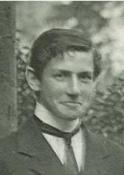
|
The King's School Canterbury |
Roll of Honour |
| Private William Frederick DRUGHORN (STK/76) | |
|
10th (Service) Battalion Royal Fusiliers (City of London Regiment) (Stockbrokers) Date of birth: 8th July 1895 Date of death: 15th July 1916 Killed in action aged 21 Buried at Pozieres British Cemetery, Ovillers-la-Boisselle Plot III Row H Grave 13 |

|
| He was born in Rotterdam on the 8th of July 1895, the youngest son of John Frederick Drughorn, ship owner and merchant, and Elizabeth (nee Berlips)of Ifield Hall, Ifield in Sussex and of 77 Lancaster Gate, London. He was educated at the Abbey School, Beckenham, and the King's School Canterbury from May 1910 to December 1911, after which he went into the steamship trading business in 1912. On the outbreak of war he was living at his parent's house at 'Banavie', 27 The Avenue, Beckenham in Kent. He enlisted in the 10th Battalion Royal Fusiliers on the 29th of August 1914 at St Paul's Churchyard in London. He was sent for training and was admitted to Colchester Hospital on the 4th of September with an injury, being released on the 7th. He embarked with his battalion for France on the 30th of July 1915, landing at Boulogne. At 9am on July 15th 1916 the 10th Battalion Royal Fusiliers was detailed to support an attack on the village of Pozieres. They advanced up Sausage Valley and about 300 yards from the village they came under heavy machine gun fire. It soon became clear that the attack had failed before it had started. The commanding officer asked for a barrage on the south west corner of the village, which took place and the battalion advanced again with D Company under Lieutenant F.M. Taylor making an attempt to seize the orchard on the edge of the village but they were also driven back by machine gun fire. After a pause for reorganisation the village was again bombarded from 5pm to 6pm and the signal was given to advance again. Determined and repeated attempts were made to gain the village but these were all repulsed and the battalion was driven back. Such were the losses that the battalion was withdrawn from the line after dark. After the war had started, his father, John Drughorn's Swedish operations still shipped iron ore to Holland whose final destination was Germany. Drughorn helped organise this but apparently considered that trading between two neutral countries was outside the scope of the laws against trading with the enemy. John Drughorn was charged with trading with the enemy and on 19th January 1915 was brought to trial at the Old Bailey. The judge was Mr. Justice Rowlatt, the prosecution was conducted by Mr. Muir, Mr. Humphreys and Mr. Boyd and the defence lawyers were Mr Pollock KC and Mr Barrington Ward. The trial lasted two days. The prosecution proved that Drughorn had had actual dealings in Holland with arranging the transhipment of the iron ore to Germany. The defence argued that actions in a neutral country were outside the court's jurisdiction. The defence produced good character witnesses from eminent business figures. Nevertheless Drughorn was convicted of trading with the enemy. His elevation to Baronet by David Lloyd-George in 1922 caused a scandal leading to a re-evaluation of the honours system. One source indicates that William Drughorn served under the name of William Frederick Henderson which may have been to distance himself from this incident. In 1918 Frederick Drughorn announced that he was donating ?25,000 to the school in his son's memory to be used for the construction of new science buildings at King's to be known as the "Drughorn Science Buildings". It appears though that negotiations between the school and the family broke down as the work never took place. He is commemorated on the war memorial at Crawley Sussex, on a sundial at Ifield Hall, on the Ifield memorial and on the panels on the gates outside the Crawley Memorial Gardens. |
|
Back